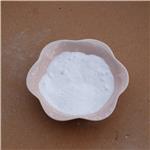Triphenylmethyl Chloride: A Comprehensive Overview
Oct 21,2024
Triphenylmethyl chloride or trityl chloride (TrCl) is a white solid with the chemical formula C19H15Cl. It is an alkyl halide commonly used in organic synthesis to introduce the trityl protecting group.

Triphenylmethyl chloride is used in the preparation of S-trityl-L-cysteine (STLC), a tight-binding inhibitor of Eg5 that prevents mitotic progression.
Preparation
Triphenylmethyl chloride is commercially available. It may be prepared by the reaction of triphenylmethanol with acetyl chloride, or by the Friedel–Crafts alkylation of benzene with carbon tetrachloride to give the trityl chloride-aluminium chloride adduct, which is then hydrolyzed.
References:
[1] FONKEN G J. Alkylation of Benzene with Triphenylmethyl Chloride[J]. Journal of Organic Chemistry, 1963, 28 7: 3A - 1948. DOI:10.1021/jo01042a510.
[2] BILL B. SMITH J E L. The Behavior of Triphenylmethyl Chloride in Nitromethane[J]. Journal of the American Chemical Society, 1955, 77 6: 1397-1714. DOI:10.1021/ja01611a101.
[3] C. GARDNER SWAIN E E P. Mechanism of Methanolysis of Triphenylmethyl Chloride in Benzene Solution1-3[J]. Journal of the American Chemical Society, 1958, 80 4: 761-1014. DOI:10.1021/ja01537a016.
- Related articles
- Related Qustion
- Triphenylmethyl chloride: properties and applications in organic synthesis Aug 3, 2023
Triphenylmethyl chloride is a versatile compound used in organic synthesis and QLED displays, undergoing nucleophilic substitution reactions.
- The uses of Triphenylchloromethane Nov 13, 2019
Triphenylchloromethane is a reagent used for the protection of amines, carboxylic acids,alcohols, and thiols.The Handling, Storage, and Precaution: use chemical safety goggles and rubber gloves.
Supplementation with pyridoxal 5'-phosphate monohydrate can synthesize neurotransmitters such as dopamine and serotonin, maintaining a healthy nervous system.....
Nov 4,2025Biochemical EngineeringL-Alaninol, a chiral amino alcohol, has gained significant attention in the chemical industry due to its versatile applications and unique properties.....
Oct 21,2024APITriphenylmethyl Chloride
76-83-5You may like
Triphenylmethyl Chloride manufacturers
- Triphenylmethyl chloride
-

- $0.00 / 25Kg/Bag
- 2025-12-16
- CAS:76-83-5
- Min. Order: 1KG
- Purity: 99%
- Supply Ability: 200mt
- TriphenylMethyl chloride
-

- $0.00 / 1Kg/Bag
- 2025-12-16
- CAS:76-83-5
- Min. Order: 1KG
- Purity: 99%min
- Supply Ability: 10 tons
- Triphenylmethyl Chloride
-

- $10.00 / 1KG
- 2025-12-11
- CAS:76-83-5
- Min. Order: 1KG
- Purity: 99%
- Supply Ability: 10 mt






